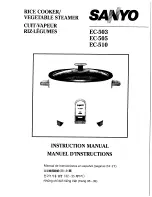
11
Slow Cooking Tips
Over the past few decades, as schedules
have become more hectic and lifestyles
more fast-paced, more and more people
have turned to slow cookers to help them
get a better handle on their time.
This KitchenAid
®
Slow Cooker offers
refinements in control that help the cooker
be a more useful tool and power to add
responsiveness and peace of mind.
Sure and Steady Cooking
A Slow Cooker is designed for you to put
food into it, walk away from it without a
worry, and return to a well-cooked meal.
So it’s important to let it do its job. That
means you should always cook with the
ceramic pot and glass lid in place, because
removing the lid reduces the temperature
inside the slow cooker and increases
cooking time.
Except where a Slow Cooker recipe
specifically directs you to remove the
lid, do not remove or lift the lid until the
minimum suggested recipe-cooking time
has elapsed. If you want to view the food
you’re cooking, tap the glass lid to remove
the condensation that has collected, and
look through the lid.
Start With Food at the Right
Temperature
Common sense is a good guide to knowing
the right temperature for food when you
start cooking in a Slow Cooker. Foods
typically stored in the refrigerator should
be added at their refrigerated temperature.
Frozen food, on the other hand, should be
thawed. And if you need to sear meat or
poultry, do that just before adding it to the
Slow Cooker – do not partially cook meat
or poultry and then refrigerate before using.
Avoid adding liquids colder than normal
refrigerated temperatures. Adding near-
freezing liquids to a warm or hot pot may
cause the pot to crack.
A Slow Cooker is a Moist Environment
Slow Cookers use a food’s own moisture to
cook the food. With the lid kept on while
cooking, very little moisture evaporates and
natural juices from the food accumulates.
For that reason, use less liquid when using
your favorite traditional recipes for slow
cooking.
Enhancing Texture and Flavor
The amount of seasonings, types of
ingredients, and when you add ingredients
can improve the texture and flavor of your
slow-cooked meals.
As a general rule for using your favorite
recipes in the slow cooker, increase the
amounts of herbs and seasonings to offset
the effect of longer cooking times.
Add garnishes, fresh herbs, and quick-
cooking vegetables toward the end of the
cooking cycle. For example, you can add
peas, corn and freshly sliced squash in the
last 10 to 20 minutes.
Also consider the differences between
related ingredients when cooking for
extended times. Dark meat poultry will
retain moisture better than white meat in
recipes cooked more than 7 to 9 hours.
Whole-grain rice, such as brown or wild
rice, retains its texture better than white
rice when it’s slow cooked. Over extended
periods, white rice can overcook and
become mushy.
When cooking soups and stews, leave a
2-inch (5 cm) space between the top of the
ceramic pot and the food so the recipe can
come to a simmer without spilling over.
Do not use frozen, uncooked meat in the
slow cooker. Always thaw meats prior to
slow cooking.
Some foods are not suited for extended
cooking. Pasta, seafood, milk, cream or
sour cream should be added 2 hours
before serving.
If cooking a vegetable-type casserole,
there will need to be a liquid in the recipe
to prevent scorching on the sides of the
ceramic pot.
Cut Food to Proper Size
The size you cut food into can affect its
taste and texture. To assure uniformity of
cooking, cut vegetables of similar density,
such as potatoes, carrots, and parsnips
into similar-sized pieces. In general, dense
vegetables should be slightly smaller than
more tender vegetables.
Cutting meats into large pieces allows
longer cooking times and avoids
overcooking.
W10407078B ENv3.indd 11
12/9/11 12:50 PM
































